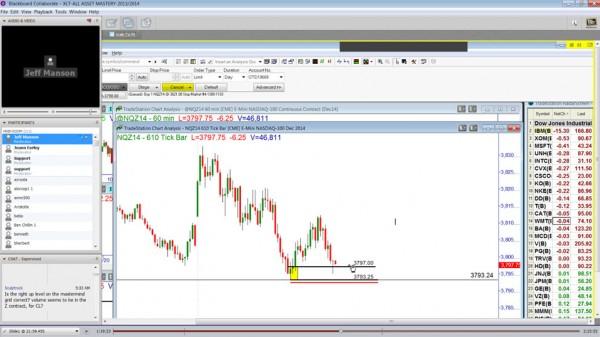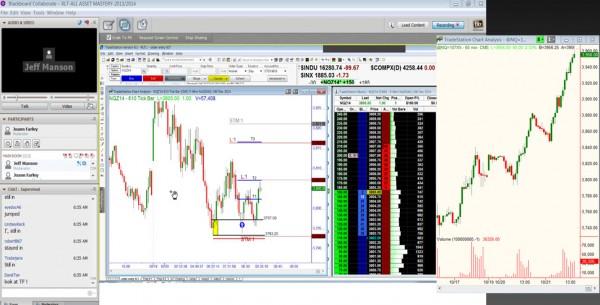![]()
Today, I want to share a trade taken in the Futures Extended Learning Track (XLT, our Live Trading Room) on October 20th, last week. The XLT is our live online trading program. The purpose of the article is to point out how important it is to keeping trading simple. I received some important questions regarding a recent trade from a recent article so I thought I would share all the details of what made this trade work to help answer those questions. Not to add complexity, but instead to dive into the psychology of what made this and many of our trades work. Always remember, not all trades are going to be profitable but that is part of trading and that’s ok, let’s begin…
Understand a simple truth, most retail traders and investors are not very successful when speculating in markets. Short term traders especially tend to lose money over all. Banks/institutions/market makers tend to do very well overall when it comes to short term trading. So, if you’re a consistent losing retail trader, it’s likely because you’re thinking and trading like one. Let’s take a look at this buying opportunity in the NASDAQ and get inside the mind of an XLT trader.
Live XLT Trading – Oct. 20th, NASDAQ Futures: The Setup
Notice the demand zone on the chart above. We know demand exceeds supply at that level because price could not stay at that level and rallied higher from it. First, the pattern told us banks were likely buying at the level as we had a Drop – Base – Rally. Second, Odds Enhancers 1, 2, and 3 also suggested there was a strong supply / demand imbalance, much more demand than supply. So, XLT students know to buy at that level with a protective sell stop just below it and our appropriate targets above. Next, once that session got going, the NASDAQ was still above the Globex low. So, let’s now think about how a retail trader is going to think in that situation. Retail traders who are going to buy that day are likely going to buy at the Globex low with a protective sell stop just below it. Retail traders who are going to sell short that day are likely going to sell short once the NASDAQ breaks below the Globex low. Our plan well before the market gets going is to buy at our demand level for all the reasons mentioned above (Odds Enhancers) and one more, the presence of a retail Bear Trap and here is how it works. Once price declines and reaches the Globex low, the retail buyers buy and place their sell stop just below. Once price declines and makes a “new low” into the level as it did on the chart below, the bearish retail traders sell short and those who bought at that low are now stopping out for a loss as their sell stops are triggered and filled. What has just happened is both retail buyers and sellers just sold when banks (and XLT traders) are big buyers. In other words, we have just caught both the retail buyers and sellers on the wrong side of the market. As institutions are buying at the demand level, retail is on the sell side which is why XLT students are buyers as well. If institutions are buying there, we want to buy.
Live XLT Trading – Oct. 20th, NASDAQ Futures: The Result
The ResultAgain, retail traders tend to perform poorly when speculating in markets. The key for you is to stop thinking and trading like a retail trader and start thinking and trading like a financial institution. Do all institutions make money, no. Overall however, they are significantly more profitable than the retail trading and investing world as most day traders lose money and most longer term investors never achieve their financial goals. As you can see on the larger time frame chart on the right, the NASDAQ ended up rallying strong, reaching all three of our profit targets and well beyond. By using our strategy that quantifies real supply and demand in the markets, we are able to predict market turns and market moves in advance with a very high degree of accuracy. This then allows for minimal risk and maximum reward whether you’re a short term income trader or longer term investor. The Bull and Bear Trap are two setups that occur frequently in markets. Learn how to properly identify and trade them to avoid falling for the trap which will cost you money and instead, get paid from the trap. As always, my hope is that this information will help lower your risk and increase your reward.
Have a great day.
Note: All information on this page is subject to change. The use of this website constitutes acceptance of our user agreement. Please read our privacy policy and legal disclaimer. Opinions expressed at FXstreet.com are those of the individual authors and do not necessarily represent the opinion of FXstreet.com or its management. Risk Disclosure: Trading foreign exchange on margin carries a high level of risk, and may not be suitable for all investors. The high degree of leverage can work against you as well as for you. Before deciding to invest in foreign exchange you should carefully consider your investment objectives, level of experience, and risk appetite. The possibility exists that you could sustain a loss of some or all of your initial investment and therefore you should not invest money that you cannot afford to lose. You should be aware of all the risks associated with foreign exchange trading, and seek advice from an independent financial advisor if you have any doubts.
Editors’ Picks
EUR/USD edges lower toward 1.0700 post-US PCE

EUR/USD stays under modest bearish pressure but manages to hold above 1.0700 in the American session on Friday. The US Dollar (USD) gathers strength against its rivals after the stronger-than-forecast PCE inflation data, not allowing the pair to gain traction.
GBP/USD retreats to 1.2500 on renewed USD strength

GBP/USD lost its traction and turned negative on the day near 1.2500. Following the stronger-than-expected PCE inflation readings from the US, the USD stays resilient and makes it difficult for the pair to gather recovery momentum.
Gold struggles to hold above $2,350 following US inflation

Gold turned south and declined toward $2,340, erasing a large portion of its daily gains, as the USD benefited from PCE inflation data. The benchmark 10-year US yield, however, stays in negative territory and helps XAU/USD limit its losses.
Bitcoin Weekly Forecast: BTC’s next breakout could propel it to $80,000 Premium

Bitcoin’s recent price consolidation could be nearing its end as technical indicators and on-chain metrics suggest a potential upward breakout. However, this move would not be straightforward and could punish impatient investors.
Week ahead – Hawkish risk as Fed and NFP on tap, Eurozone data eyed too

Fed meets on Wednesday as US inflation stays elevated. Will Friday’s jobs report bring relief or more angst for the markets? Eurozone flash GDP and CPI numbers in focus for the Euro.
RECOMMENDED LESSONS
Making money in forex is easy if you know how the bankers trade!
Discover how to make money in forex is easy if you know how the bankers trade!
5 Forex News Events You Need To Know
In the fast moving world of currency markets, it is extremely important for new traders to know the list of important forex news...
Top 10 Chart Patterns Every Trader Should Know
Chart patterns are one of the most effective trading tools for a trader. They are pure price-action, and form on the basis of underlying buying and...
7 Ways to Avoid Forex Scams
The forex industry is recently seeing more and more scams. Here are 7 ways to avoid losing your money in such scams: Forex scams are becoming frequent. Michael Greenberg reports on luxurious expenses, including a submarine bought from the money taken from forex traders. Here’s another report of a forex fraud. So, how can we avoid falling in such forex scams?
What Are the 10 Fatal Mistakes Traders Make
Trading is exciting. Trading is hard. Trading is extremely hard. Some say that it takes more than 10,000 hours to master. Others believe that trading is the way to quick riches. They might be both wrong. What is important to know that no matter how experienced you are, mistakes will be part of the trading process.


